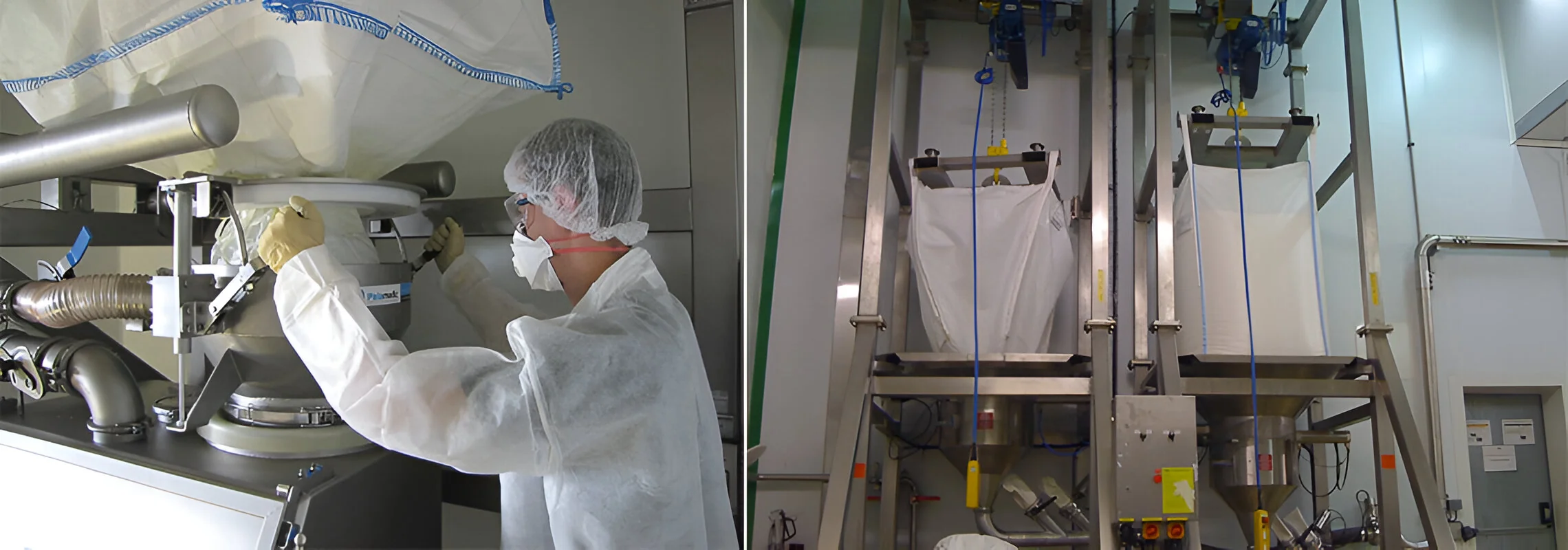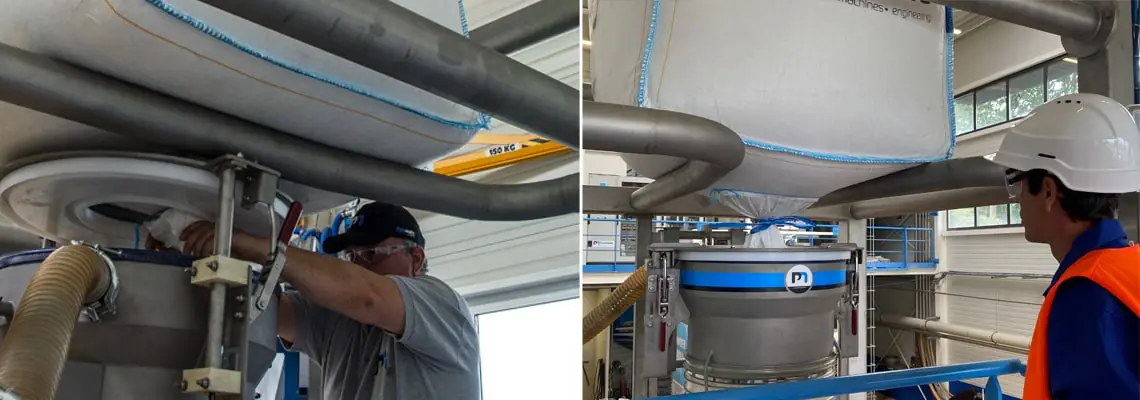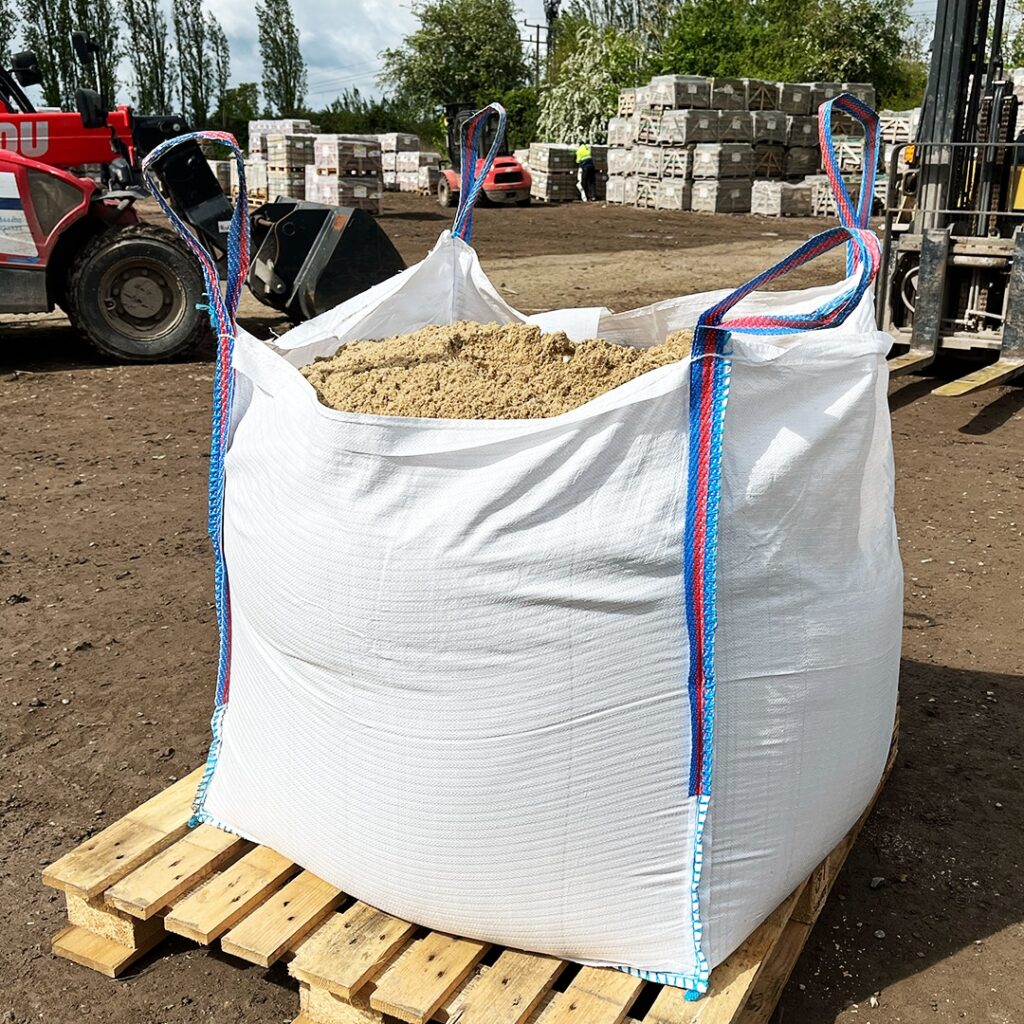Unloading bulk bags can be challenging and time-consuming, presenting significant obstacles for industries dependent on efficient bulk bag handling.
Without the appropriate machinery designed to handle super sacks, manual unloading becomes labor-intensive, error-prone, and potentially hazardous.
By employing proper techniques and investing in bulk bag handling equipment, businesses can overcome the challenges of super sack unloading, enhance operational efficiency, and minimize potential risks. Images in this article are courtesy of Palamatic Process, a leader in bulk material and powder handling.
Let’s start with some general guidance and tips…
Bulk Bag Handling General Tips & Advice
Bulk Bag Unloading

Image credit: Palamatic Process
- Safety first: Always prioritize safety when handling super sacks by ensuring personnel are adequately trained and equipped with appropriate PPE.
- Pre-handling inspection: Inspect super sacks for damage, tears, or defects. Check for proper labeling and ensure the bag is suitable for the material.
- Load capacity: Adhere strictly to the super sack’s weight capacity. Overloading can lead to bag failure and accidents.
- Secure attachment: Ensure the super sack is securely attached to handling equipment, such as lifters or hooks, before lifting or moving it. Follow the manufacturer’s guidelines to prevent bag slippage or instability.
- Avoid bag damage: Avoid dragging or sliding the bag on rough surfaces or sharp edges that could cause tears or punctures.
- Proper storage: Store super sacks in a clean, dry area away from direct sunlight, extreme temperatures, or moisture. Protect the bags from pests to maintain their integrity.
- Training and communication: Promote effective communication among employees involved in super sack handling. Encourage prompt reporting of issues. Regular training can improve handling techniques and safety awareness.
- Environmental considerations: Dispose of used or damaged super sacks responsibly, following local regulations. Consider recycling or reusing the bags to minimize waste.
- Regular maintenance: Keep handling equipment in good working condition with regular inspections and preventive maintenance. Address issues promptly for safe and efficient operations.
For efficient and safe unloading and loading of super sacks, consider the following tips:
Bulk Bag Unloading Tips

Image credit: Palamatic Process
- Bag inspection: Always inspect super sacks for damages or defects before unloading or loading to prevent spills or accidents.
- Appropriate equipment: Use suitable equipment for the weight and type of material in the super sacks. Automated machinery, such as forklifts or cranes, can save time and reduce injury risk.
- Get organized: Ensure a clear and organized workspace to prevent obstacles or tripping hazards. Clear routes for equipment movement.
- Apply correct techniques: Follow proper manual handling guidelines to avoid strain or injuries, even when using handling and loading equipment.
- Communication: Establish clear signals and instructions among the team to ensure coordinated unloading and loading processes.
Bulk Bag Handling Equipment Options
Handling bulk bags can be challenging without the right equipment. Here are some top bulk bag handling equipment options:
Bulk Bag Unloaders
Designed for precision, bulk bag unloaders handle multiple super sacks and large quantities of bulk materials seamlessly. They feature robust construction and can withstand heavy-duty applications and high-density materials.
 Bulk Bag Lifting Device
Bulk Bag Lifting Device
A bulk bag lifting device simplifies the process of handling and unloading bulk bags, offering a convenient and safe solution. It features advanced safety points, sturdy construction, and adaptability for various super sack sizes, enhancing productivity and safety.
Bulk Bag Discharger/Dispenser
This equipment facilitates efficient and controlled unloading of bulk bags into downstream processes or storage containers. It includes adjustable retention devices, spout interfaces, and flow control mechanisms, ensuring accurate material flow and preventing spills.
Bulk Bag Hopper
A bulk bag hopper securely receives and stores the contents of super sacks, preventing material bridging or clogging with integrated agitators and flow promotion devices.
Bulk Bag Stand
A bulk bag stand supports and elevates bulk bags during storage or handling, preventing damage from moisture or pests. It ensures safe and efficient handling with a stable base and protective coatings.
Key Takeaways on Bulk Bag Handling Equipment
Super sack handling equipment minimizes manual effort and enhances safety, accommodating various sack sizes and weights. Investing in this equipment improves efficiency, productivity, and operational safety, making it a valuable asset for businesses dealing with bulk materials.
For bulk bag handling solutions, consider FIBC Vietnam – Jumbo Bag VN. Contact us today to discuss your needs.





 Bulk Bag Lifting Device
Bulk Bag Lifting Device

